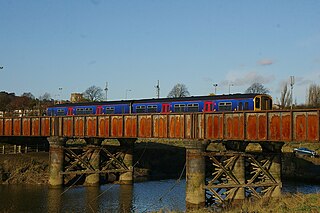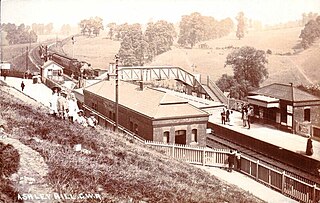Related Research Articles

Bristol Temple Meads is the oldest and largest railway station in Bristol, England. It is located 118 miles 31 chains away from London Paddington. It is an important transport hub for public transport in the city; there are bus services to many parts of the city and surrounding districts, with a ferry to the city centre. Bristol's other major station, Bristol Parkway, is a more recent station on the northern outskirts of the conurbation. It is the busiest station in South West England.

Bristol Parkway, on the South Wales Main Line, serves the villages of Stoke Gifford and Harry Stoke in South Gloucestershire, England. Despite its name, it is located in Gloucestershire rather than Bristol itself. It is 112 miles (180 km) from London Paddington. The station was opened in 1972 by British Rail. It is the third-most heavily used station in the West of England local authority area, after Bristol Temple Meads and Bath Spa. There are four platforms, and a well-equipped waiting area. The station is managed by Great Western Railway, who provide most of the trains at the station, with CrossCountry providing the rest.

The Severn Beach line is a local railway line in Bristol and Gloucestershire, England, which runs from Bristol Temple Meads to Severn Beach, and used to extend to Pilning. The first sections of the line were opened in 1863 as part of the Bristol Port Railway and Pier; the section through Bristol was opened in 1875 as the Clifton Extension Railway.

Stapleton Road railway station is on the Severn Beach Line and Cross Country Route, serving the inner-city district of Easton in Bristol, England. It is 1.6 miles (2.6 km) from Bristol Temple Meads. Its three letter station code is SRD. The station has two platforms, four running lines and minimal facilities. It is managed by Great Western Railway, the seventh company to be responsible for the station, and the third franchise since privatisation in 1997. They provide all train services at the station, the standard service being two trains per hour along the Severn Beach Line and an hourly service between Bristol Temple Meads and Filton Abbey Wood.

Filton Abbey Wood railway station serves the town of Filton in South Gloucestershire, England; it is located 4.4 miles (7.1 km) from Bristol Temple Meads. There are four platforms but minimal facilities. The station is managed by Great Western Railway that operates all services that call here. The general service level is nine trains per hour: two to Cardiff Central, two towards Gloucester, one towards Taunton, two towards Westbury and two to Bristol Temple Meads.

Patchway railway station is on the South Wales Main Line, serving the town of Patchway and village of Stoke Gifford in South Gloucestershire, England. It is 6 miles (10 km) from Bristol Temple Meads. Its three letter station code is PWY. It is managed by Great Western Railway, who provide all train services at the station; there is generally a train every hour in each direction between Cardiff Central and Taunton.
Bristol is a city in south west England, near the Bristol Channel coast, approximately 106 miles (170 km) west of London. Several factors have influenced the development of its transport network. It is a major centre of employment, retail, culture and higher education, has many historic areas, and has a history of maritime industry. The city has a population of 450,000, with a metropolitan area of 650,000, and lies at the centre of the former County of Avon, which includes many dormitory towns, and has a population of one million.

Lawrence Hill railway station is on the Severn Beach Line and Cross Country Route, serving the inner-city districts of Easton and Lawrence Hill in Bristol, England. It is 1.0 mile (1.6 km) from Bristol Temple Meads. Its three letter station code is LWH. The station has two platforms, four running lines and minimal facilities. It is managed by Great Western Railway, the seventh company to be responsible for the station and the third franchise since privatisation in 1997. They provide all train services at the station, the standard service being two trains per hour along the Severn Beach Line and an hourly service between Bristol Temple Meads and Filton Abbey Wood.
Chittening Platform railway station was a station on the former Great Western Railway between Filton and Avonmouth.

The Henbury Loop Line, also known as the Filton to Avonmouth Line, is a railway line following the boundary between Bristol and South Gloucestershire between the Severn Beach Line at Hallen Marsh Junction, Avonmouth and the Cross Country Route/South Wales Main Line at Filton. It is currently only used for freight.
Rail services in the West of England refer to passenger rail journeys made in the Bristol commuter area. 17 million passenger rail journeys were made in 2019-20 within the Gloucestershire, Wiltshire and Bristol/Bath region.

The Bristol and South Wales Union Railway was built to connect Bristol, England, with south Wales. The route involved a ferry crossing of the River Severn but was considerably shorter than the alternative route through Gloucester. The ferry was replaced by the Severn Tunnel in 1886 but part of the route continues to be used, forming parts of the Cross-Country Route and the South Wales Main Line.

Ashley Hill railway station was a railway station serving the area of Ashley Down in the north of Bristol, England. It was located on what is now known as Filton Bank. It was served by stopping trains to Severn Beach, Avonmouth and Swindon . The West of England Combined Authority plan to open a new train station, to be called Ashley Down, on the site of Ashley Hill station, in 2024.

Horfield railway station was a railway station serving the northern part of Horfield and Lockleaze in the north of Bristol, England. It was located on the main line from Bristol to South Wales. It was served by stopping trains to Severn Beach, Avonmouth and Swindon.

MetroWest, formerly known as the Greater Bristol Metro, is a project to improve the rail services in Bristol, England, and the surrounding region. It was first proposed at First Great Western's Stakeholder Event in March 2008. The aim of the project is to develop half-hourly services through central Bristol which will also serve the surrounding West of England region. Transport campaigning groups Friends of Suburban Bristol Railways (FoSBR) and Transport for Greater Bristol are actively supporting the proposal, as are the three unitary authorities under the West of England Combined Authority and North Somerset Council.

Bristol Supertram was a proposed light rail system for the Bristol and South Gloucestershire regions of England. In 2001, the project was given backing from the government to build a line that would link the city centre with the North Bristol region, but the project was cancelled in 2004.

North Filton Platform was a railway station which served the northern part of Filton, Gloucestershire, England. It was on the railway line between Filton and Avonmouth, and was situated on the western side of Gloucester Road.
Bristol Rail Campaign is a Bristol-based campaign group, calling for better rail transport in the Bristol area.

Henbury railway station served the Bristol suburb of Henbury, England, from 1910 to 1965. The station was situated on the Henbury Loop Line of the Great Western Railway and was opened on 9 May 1910 for passenger services. Under the Beeching cuts, it was closed to passengers on 23 November 1964, with goods services ceasing on 5 July 1965. There is a proposal to reopen the station as part of the Greater Bristol Metro scheme.
Charlton Halt railway station was a railway station which served the village of Charlton, west of Filton in South Gloucestershire, England, on the Avonmouth and Filton Railway, now known as the Henbury Loop Line. The station was open only between May 1910 and March 1915, when the line was closed to passengers. The line was reopened to passengers from 1922 to 1964, but the station was not reopened.
References
- ↑ "New Ashley Down railway station construction gets under way". BBC News. 7 March 2023. Retrieved 6 June 2023.
- 1 2 3 "Ashley Down station Proposed access designs". travelwest. Retrieved 29 April 2021.
- ↑ "Study to take place into plans for new station". The Bristol Post . Northcliffe Media. 17 September 2013. Retrieved 10 October 2013.
- ↑ Wood, Dave (16 September 2013). "New tracks, new stations will provide opportunities" . Retrieved 10 October 2013.
- ↑ "Costs set to signal end of plan to reopen city railway station". Bristol Post . Local World. 6 November 2013. Retrieved 26 November 2013.
- ↑ Johnston, Howard (27 November – 10 December 2013). "Regional News". RAIL . Vol. 736. Haymarket Publishing. p. 24.
- ↑ "North Bristol to get new train station". 29 January 2018.
- ↑ Wilson, Kate (20 June 2019). "Latest on opening of new Bristol train station". BristolLive. Retrieved 6 June 2023.
- ↑ "New Ashley Down railway station construction gets under way". BBC News. 7 March 2023. Retrieved 8 March 2023.
- ↑ "Latest on opening of new Bristol train station". 20 June 2019.